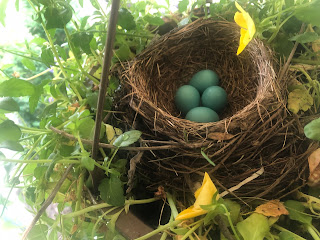For the last couple of weeks, we have been entering the house through the garage and not using the front door. The reason, a momma robin built a nest in a hanging plant next to our front door and she produced four “robin’s egg blue” eggs and had been nesting there for a couple of weeks.
The babies hatched on June 5 and 6 and left on June 19th or 20th, right on schedule. It’s been a fascinating experience to follow the process and I tried being as unobtrusive as possible while taking pictures every day or so.
Pam hangs a plant in the same spot under the front porch roof nearly every year and we have had smaller birds nest there in the past, usually chickadees or finches. But this year a fully-grown robin couple decided to set up housekeeping in our plant. I noticed a robin sitting in the basket in early June and when she was away, I took some pictures and observed four eggs in the nest.
The next day, I took another photo and noticed three chicks and one unhatched egg. According to the Audubon Society’s website, it usually takes one or two days for all the eggs to hatch, and those four eggs is an average size clutch.
I jokingly named the un-hatched egg chick “Pam” after my wife who is a notoriously late riser. And, true to form she hatched a day later than the others.
It usually takes about two weeks for the chicks to develop enough to be able to fly away. Right after hatching they hadn’t developed feathers yet, but they did have an appetite! Both parents gather food—worms, insects, and berries—and bring the food back to the nest for the babies.
For the first five days after hatching, baby robins can’t see as their eyes are covered while they develop. So, need to be fed and kept secure by their parents.
By day nine, the robins had developed some feathers and their eyes were open and they could see. At this point, one of the chicks seems to object being photographed. I hope I don’t hear from their lawyer!
At this point, the chicks begin to make more noise and I observed them sticking their heads out of the nest and making more sounds and they are only about four or five days away from leaving the nest. After they leave, neither the chicks nor their parents will return to this nest. Robins always build a new nest for the next family. I have read that cowbirds will use a robin’s nest, so this one may be repurposed in the future.
The day before they left, I observed one of the adults return to the nest and have what appeared to be a heated discussion with the chicks for about 15 seconds. That adult then flew over to the maple tree in our front yard and sat observing the nest. About five or ten minutes later, another adult flew into the nest and had the same type of animated conversation with the chicks for about 15 seconds. I wonder if mom and dad were giving their “kids” orders that it is time to get on with life.
The big day finally arrived on schedule. That morning I didn’t hear or see any activity around the nest. And my photo confirmed that the chicks and momma had left the nest. Also, the next was totally cleaned out with only a single leaf remaining. Once the chicks hatch, the mother typically eats the shell fragments as a source of calcium for her diet.
The four baby birds are now out in the big bad world and will have to fend for themselves. One tragic note is that the analytics by researchers say that only one of the four chicks will survive for more than a year and the average length of a robin’s life is two years.
Depending on her age and ability to escape predators, momma robin may produce one or two more clutches of eggs this summer. So, she could eventually produce about a dozen chicks and have a very busy summer.
I wish the four robins good luck as they begin their new adventure. They are going to need it.






No comments:
Post a Comment